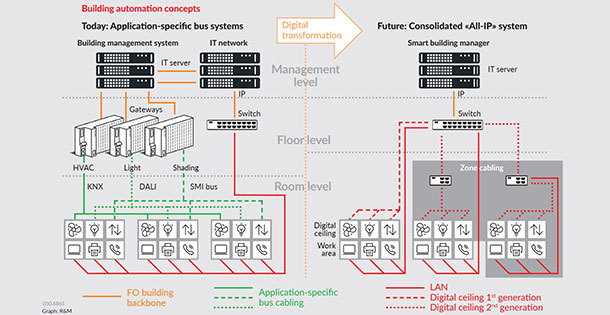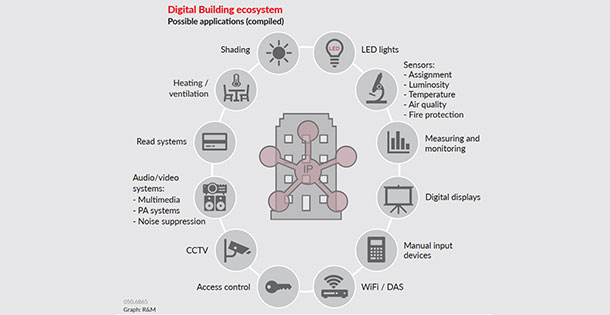Buildings have evolved tremendously in recent decades and the Middle East is now home to some truly impressive works of architecture, from the world’s tallest tower to buildings that have earned their place as global icons for their aesthetics and sustainable design. While these marvels of modern engineering characterise the skylines of cities across the region, there is a clear eagerness to go a step further. The rapid advancement of technology has made it possible to not only imagine the natural evolution of buildings, but also realise their transformation into Smart Buildings.
By utilising technology to automate the operation of building systems such as lighting, alarms, fire and life safety, HVAC and more, these structures have the potential to greatly enhance the safety, efficiency, and comfort of occupants. Moreover, building owners can achieve these benefits while simultaneously enjoying increases in efficiency and reductions in cost owing to the streamlining of operations.
With clear reasons to transforming new and existing developments into intelligent buildings, industry stakeholders are now tasked with identifying and understanding which technologies they must invest in. Investors, building owners, planners and system integrators ask themselves this question on a daily basis and if centuries worth of accumulated knowledge is anything to go by, the answer should be clear. Just as in their traditional counterparts, intelligent buildings too must be built on a solid foundation, which in this case is the underlying network.

The gathering, processing and analysis of data from sensors and systems located all across the premises is fundamental to making a building smart. IP-based systems, also known as networked systems, are what make this possible. These systems use Internet Protocol to communicate with each other through IP addresses and data packets and all types of building systems, from HVAC controls to digital signage, can be IP-based.
R&M is convinced that, unlike field bus systems that are presently being used in buildings, All-over-IP networks open up better possibilities for the development for smart buildings. All-over-IP means that all devices involved in building technology and building management communicate in the same way, without barriers, over Ethernet Internet Protocol, Ethernet IP. And this seamless communication is possible over the local data network, as well as over the Internet and cloud. When combined with Power over Ethernet technologies, these systems have the ability to also address the question of power supply as now, both power and data can reliably and efficiently be connected via the same cable. So, let’s take a look at some of the advantages of All-over-IP networks to understand why they are the foundation for smart buildings.

Investment: Devices and systems which work with Ethernet IP technology are favourably priced as competition, uncomplicated standards and mass production reduce the manufacturing costs. Furthermore, open standards and license-free software, which is free of charge, simplify the engineering of All-over-IP solutions.
Connectivity: IP devices and networks speak the same language, end to end. They do not need any translation between the server, operating systems such as with gateways, and end devices. They are easy to connect to each other with standardised RJ45 cable interfaces which simplifies installation, commissioning and maintenance.
Performance: The Ethernet IP protocol enables the transmission of large quantities of data faster than field bus systems. This makes it possible to collect and distribute data from the entire network. The availability of a fast data connection allows new data-intensive applications such as HD video or analytics to be used.
Scalability: Buildings can be connected and controlled digitally throughout. The current Internet Protocol Version 6 can theoretically allocate 1,500 IP addresses per square meter. In practical implementations, there is no limit to the number of devices which can be addressed.
Security: The star-shaped topology reduces the number of connection points and gives IP networks more operational reliability. The access controls and authentication measures incorporated in the IP improve the security of building automation.
Add-ons: Thanks to the total availability of data from different components, new applications and technical solutions can be developed. An administrator can integrate these with the click of a mouse.
Future-proof: The Institute of Electrical and Electronics Engineers is already working on the next generation of transmission technology with the new Single Pair Ethernet, SPE, standard for network connectivity. SPE will reduce the costs of connectivity even further and decrease the size too. It is not, however, supposed to replace existing solutions but rather build on and extend them. SPE will be ideal for connecting a large number of small sensors and actuators which is essential to unlocking the potential of the Internet of Things.
With All-over-IP solutions, the realisation of intelligent buildings will become less expensive and far less complex. They will thus become more flexible and will be implemented more frequently. This means that as an industry, we can move ever closer to the vision of an ecological, economical, convenient and secure building.
By Nabil Khalil, Executive Vice-President of R&M Middle East, Turkey and Africa.



















